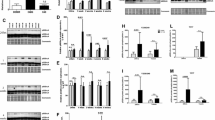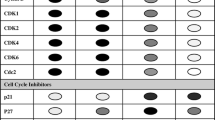Abstract
A number of recent studies have suggested that cardiac myocytes, previously considered post-mitotic, re-enter the cell cycle and possess the ability to proliferate with certain pathogenic stimuli. To study this further, we examined cellular proliferation in myocardial tissue from subjects with chronic ischemic heart disease-associated myocardial infarction and subsequent congestive heart failure. We found striking increases in cytoplasmic phospho-p27, a well-known mitotic regulator, compared to controls by both immunocytochemical and immunoblot analyses. However, we found no evidence for cardiac myocyte proliferation in either disease or control subjects using both mitotic counting (no mitotic figures were observed) and Ki-67 immunocytochemistry, which demonstrated a 0% proliferation index. That increased cytoplasmic phospho-p27 is not accompanied by division prompts us to speculate that ectopic cell cycle activation occurs in the face of minimal to absent myocyte proliferation per se. Based on these findings, and the parallel findings in post-mitotic neurons in neurodegenerative disease, we suggest that cell-cycle activation in ischemic heart disease is a deleterious event that perpetuates disease pathogenesis culminating in myocardial failure.
Similar content being viewed by others
References
Agah R, Kirshenbaum LA, Abdellatif M et al (1997) Adenoviral delivery of E2F-1 directs cell cycle reentry and p53-independent apoptosis in postmitotic adult myocardium in vivo. J Clin Invest 100:2722–2728
Baldassarre G, Belletti B, Bruni P et al (1999) Overexpressed cyclin D3 contributes to retaining the growth inhibitor p27 in the cytoplasm of thyroid tumor cells. J Clin Invest 104:865–874
Beltrami AP, Urbanek K, Kajstura J et al (2001) Evidence that human cardiac myocytes divide after myocardial infarction. N Engl J Med 344:1750–1757
Blain SW, Massague J (2002) Breast cancer banishes p27 from nucleus. Nat Med 8:1076–1078
Carrano AC, Eytan E, Hershko A, Pagano M (1999) SKP2 is required for ubiquitin-mediated degradation of the CDK inhibitor p27. Nat Cell Biol 1:193–199
Ciaparrone M, Yamamoto H, Yao Y et al (1998) Localization and expression of p27KIP1 in multistage colorectal carcinogenesis. Cancer Res 58:114–122
Esposito G, Rapacciuolo A, Naga Prasad SV et al (2002) Genetic alterations that inhibit in vivo pressure-overload hypertrophy prevent cardiac dysfunction despite increased wall stress. Circulation 105:85–92
Izumo S, Nadal-Ginard B, Mahdavi V (1988) Protooncogene induction and reprogramming of cardiac gene expression produced by pressure overload. Proc Natl Acad Sci USA 85:339–343
Kajstura J, Leri A, Finato N et al (1998) Myocyte proliferation in end-stage cardiac failure in humans. Proc Natl Acad Sci USA 95:8801–8805
Liang J, Zubovitz J, Petrocelli T et al (2002) PKB/Akt phosphorylates p27, impairs nuclear import of p27 and opposes p27-mediated G1 arrest. Nat Med 8: 1153–1160
McShea A, Harris PL, Webster KR, Wahl AF, Smith MA (1997) Abnormal expression of the cell cycle regulators P16 and CDK4 in Alzheimer's disease. Am J Pathol 150:1933–1939
Narula J, Haider N, Virmani R et al (1996) Apoptosis in myocytes in end-stage heart failure. N Engl J Med 335:1182–1189
Ogawa O, Lee HG, Zhu X et al (2003) Increased p27, an essential component of cell cycle control, in Alzheimer's disease. Aging Cell 2:105–110
Olivetti G, Cigola E, Maestri R et al (1996) Aging, cardiac hypertrophy and ischemic cardiomyopathy do not affect the proportion of mononucleated and multinucleated myocytes in the human heart. J Mol Cell Cardiol 28:1463–1477
Olivetti G, Abbi R, Quaini F et al (1997) Apoptosis in the failing human heart. N Engl J Med 336:1131–1141
Raina AK, Zhu X, Rottkamp CA et al (2000) Cyclin' toward dementia: cell cycle abnormalities and abortive oncogenesis in Alzheimer disease. J Neurosci Res 61:128–133
Reynisdottir I, Polyak K, Iavarone A, Massague J (1995) Kip/Cip and Ink4 Cdk inhibitors cooperate to induce cell cycle arrest in response to TGF-beta. Genes Dev 9:1831–1845
Sadoshima J, Izumo S (1997) The cellular and molecular response of cardiac myocytes to mechanical stress. Annu Rev Physiol 59:551–571
Sano M, Abdellatif M, Oh H et al (2002) Activation and function of cyclin T-Cdk9 (positive transcription elongation factor-b) in cardiac muscle-cell hypertrophy. Nat Med 8:1310–1317
Singh SP, Lipman J, Goldman H et al (1998) Loss or altered subcellular localization of p27 in Barrett's associated adenocarcinoma. Cancer Res 58:1730–1735
Sternberger LA (1986) Immunocytochemistry. Wiley, New York
Sutterluty H, Chatelain E, Marti A et al (1999) p45SKP2 promotes p27Kip1 degradation and induces S phase in quiescent cells. Nat Cell Biol 1:207–214
Tamamori-Adachi M, Ito H, Sumrejkanchanakij P et al (2003) Critical role of cyclin D1 nuclear import in cardiomyocyte proliferation. Circ Res 92:e12–e19
Tortosa A, Vinolas N, Villa S et al (2003) Prognostic implication of clinical, radiologic, and pathologic features in patients with anaplastic gliomas. Cancer 97:1063–1071
Ueno H, Perryman MB, Roberts R, Schneider MD (1988) Differentiation of cardiac myocytes after mitogen withdrawal exhibits three sequential states of the ventricular growth response. J Cell Biol 107:1911–1918
Verdecchia P, Carini G, Circo A et al (2001) Left ventricular mass and cardiovascular morbidity in essential hypertension: the MAVI study. J Am Coll Cardiol 38:1829–1835
Viglietto G, Motti ML, Bruni P et al (2002) Cytoplasmic relocalization and inhibition of the cyclin-dependent kinase inhibitor p27(Kip1) by PKB/Akt-mediated phosphorylation in breast cancer. Nat Med 8:1136–1144
Xiao G, Mao S, Baumgarten G et al (2001) Inducible activation of c-myc in adult myocardium in vivo provokes cardiac myocyte hypertrophy and reactivation of DNA synthesis. Circ Res 89:1122–1129
Zhu X, Rottkamp CA, Boux H et al (2000) Activation of p38 kinase links tau phosphorylation, oxidative stress, and cell cycle-related events in Alzheimer disease. J Neuropathol Exp Neurol 59:880–888
Author information
Authors and Affiliations
Corresponding author
About this article
Cite this article
Smith, M.A., Zhu, X., Lee, Hg. et al. Sequestration of p27 within the cytoplasm of cardiac myocytes in chronic ischemic heart disease: pathogenic implications for ischemic cardiomyopathy. AGE 28, 85–91 (2006). https://doi.org/10.1007/s11357-006-9001-0
Received:
Revised:
Accepted:
Published:
Issue Date:
DOI: https://doi.org/10.1007/s11357-006-9001-0




